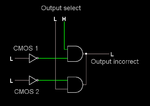Mutad0r
Junior Member level 3
So I'm making a processor just for the fun of it and in various situations I will have to select between outputs, for example, should the output signal be from the full adder, a logic shift or whatever else the processor has. I'm not entirely sure how to implement this.
At first glance you could use an AND gate to sort of "enable" a signal to pass through, but the problem is that a CMOS logic gate actively pulls the output to ground if it's set to 0. This is demonstrated in the following image.

I haven't gotten a solution to this so far, so halp.
What I basically need is to have a gate that allows the digital signal to pass through, but otherwise lets the output float freely, without pulling it up or down.
At first glance you could use an AND gate to sort of "enable" a signal to pass through, but the problem is that a CMOS logic gate actively pulls the output to ground if it's set to 0. This is demonstrated in the following image.

I haven't gotten a solution to this so far, so halp.
What I basically need is to have a gate that allows the digital signal to pass through, but otherwise lets the output float freely, without pulling it up or down.